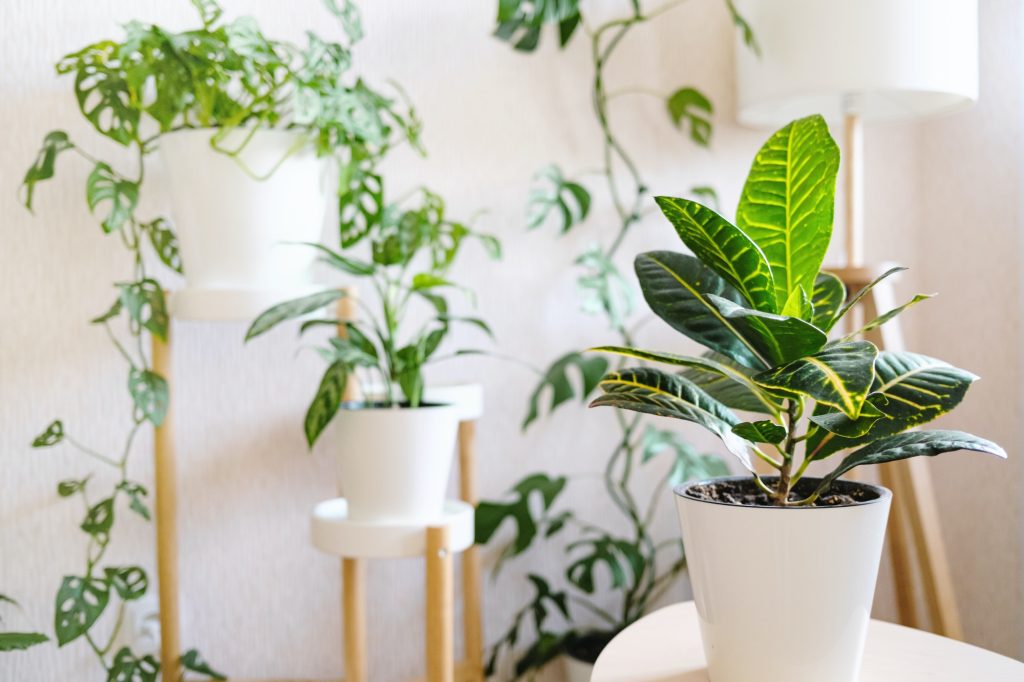When it comes to the most attractive and artistic house plants, the Croton plant tops the list because of its multicolored attribute and foliage design. The Croton plant has colors ranging from different hues of green, yellow, red, purple, cream, and burgundy.
The Croton family boasts of over 15 beautiful varieties and these varieties differ in foliage color, size, shape, and design.
It is a great option for beginners because it is easy to propagate and does not demand many resources so far the basic requirements are provided. These requirements include watering, lighting, proper soil mix, and an appropriate container.
The requirements make the Croton plant a low-maintenance plant. Most of the varieties are popular so they are not expensive. The Croton plant can be easily purchased from nearby or online stores.
If you are considering starting Croton propagation, here is a list of croton varieties to begin your propagation journey.
15 Croton Plant Varieties for Every Plant Parent
The Croton plant is perfect as a spice-up for both the interior and exterior design of your home.
The beauty of the Croton plant is accented when it is grown in attractive and appropriate containers. This is a list of the most common croton varieties you can propagate in your home alongside their features and requirements needed to survive.
1. Garden Croton Plant
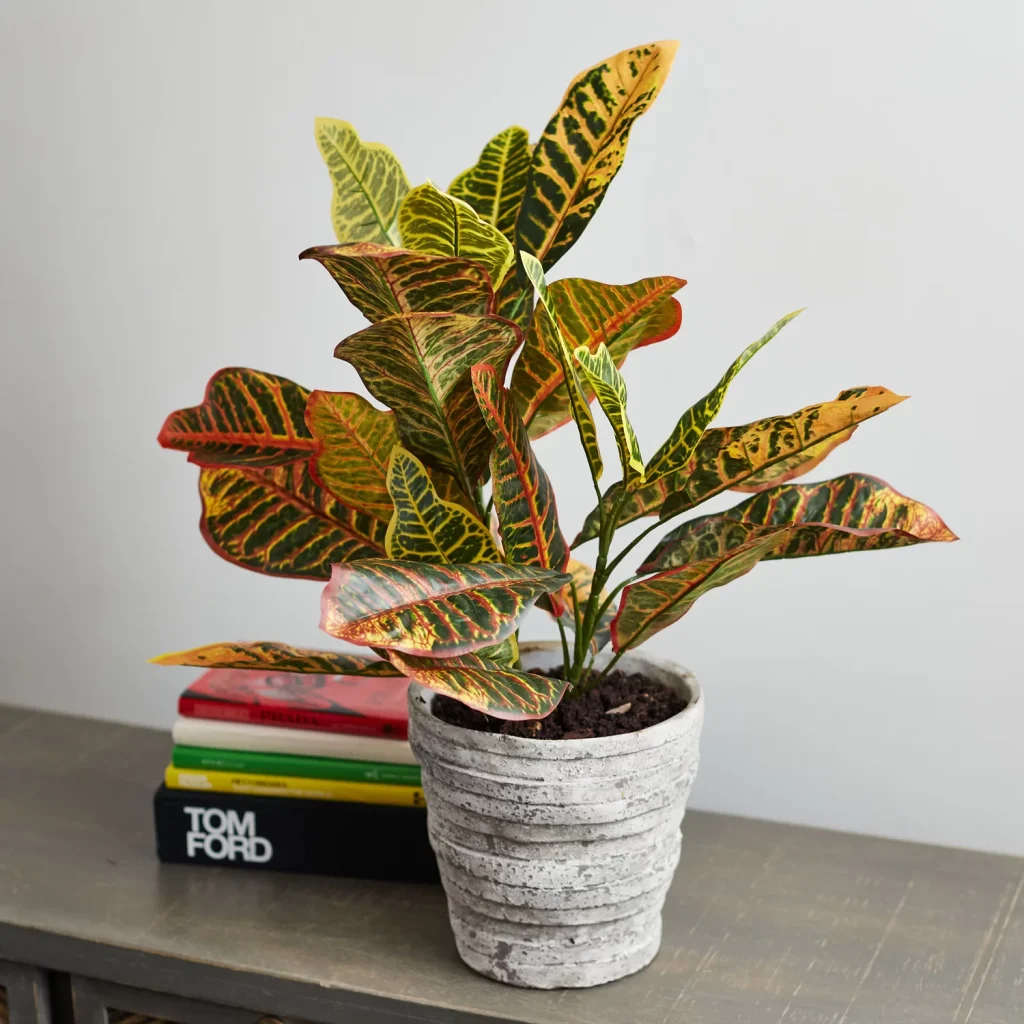
This Croton variety is popular for its large and oval-shaped leaves. The foliage appears in different colors ranging from green, yellow, pink, and red.
The veins of the Garden Croton are most times marked with yellow stripes. This croton variety grows best in organic soil that drains well. They can be grown both indoors and outdoors; those grown indoors grow as wide and large as those grown outdoors.
When grown indoors, this croton variety must be placed in locations where they can receive bright indirect light. If natural light is insufficient, make use of artificial light from lamps or bulbs. The appropriate temperature for the croton plant is 55 °F-80 °F.
The Garden croton does well with shocks that mat comes from transplanting or repotting; if you notice the leaves are falling off, be patient till the croton plant recovers from the shock.
2. Croton Zanzibar Plant
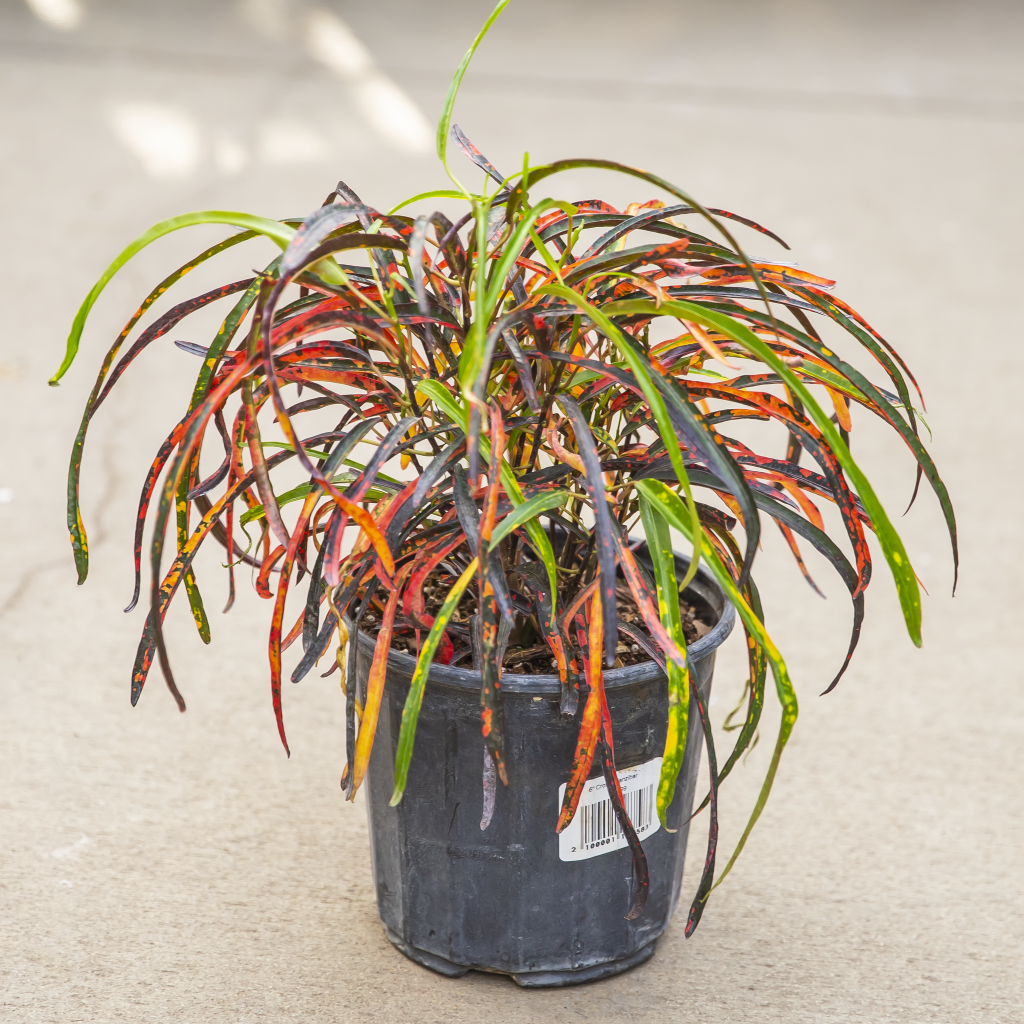
This croton plant is one of the most distinct in the croton varieties family. The croton Zanzibar is recognized for its narrow, long, and palm-like leaves. The croton Zanzibar can easily be referred to as a mini palm because their leaves are very similar.
This unique croton is marked with green, pink, and yellow colors. They can be grown indoors and outdoors.
Grow them in attractive containers to accent their beauty or you could place them in dangle baskets. They thrive in humid temperatures since they are tropical plants. Misting is a sure way of improving the humidity of the plant.
Also, humidifiers can suffice. Their basic requirements include adequate lighting, sufficient watering, organic soil, moist soil, and a well-drilled pot. Regular pruning helps maintain the shape and appearance of the plant.
3. Banana Croton Plant
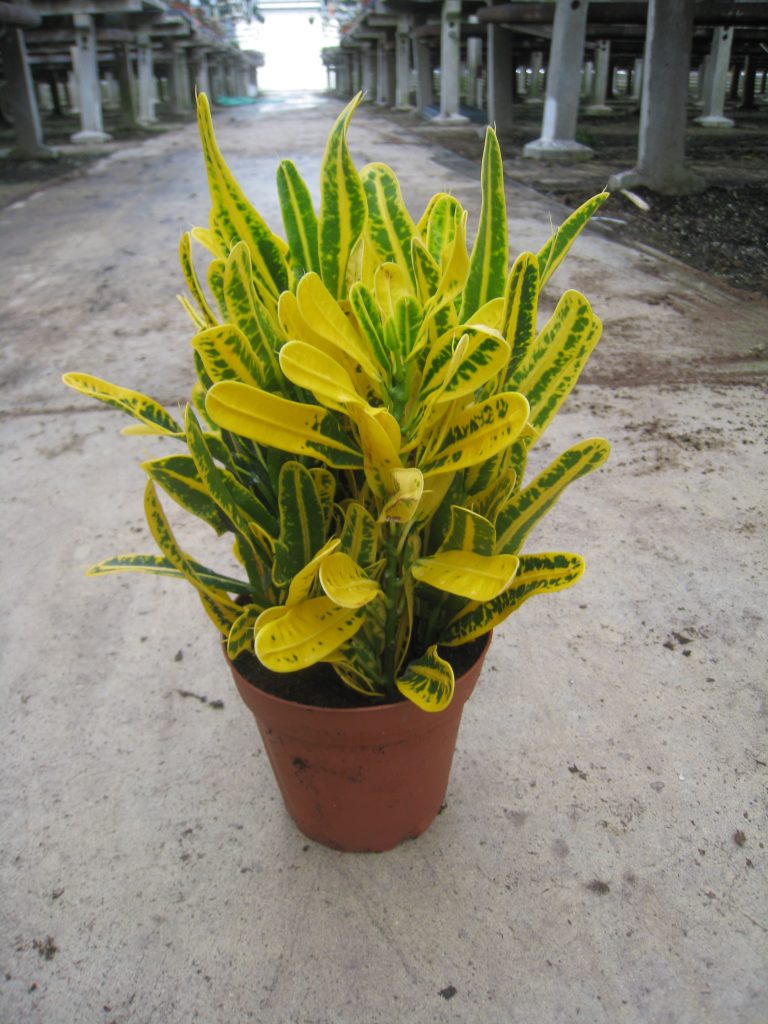
Like the Banana fruit, the dominant colors of this variety are green and yellow. The foliage appearance is marked with splotches of both yellow and green while some of the leaves are plain green. When properly tended to, the Banana croton grows into lush-looking oval-shaped leaves.
Since they are easy to propagate, they are great options for beginners.
They thrive in organic soil; the organic content of your soil can be improved by adding compost or perlite. A change in the foliage appearance of the Banana croton plant can be disheartening because its beauty is in the brightness of the foliage color.
Change in foliage appearance usually happens when the plant has been exposed to overwatering, under watering, root rot, inadequate lighting, and pest infestations. Identify what you may be doing wrong to fix the issue. For dried leaves, there are no chances of recovery so just snip them off to boost their growth.
4. Iceton Croton Plant
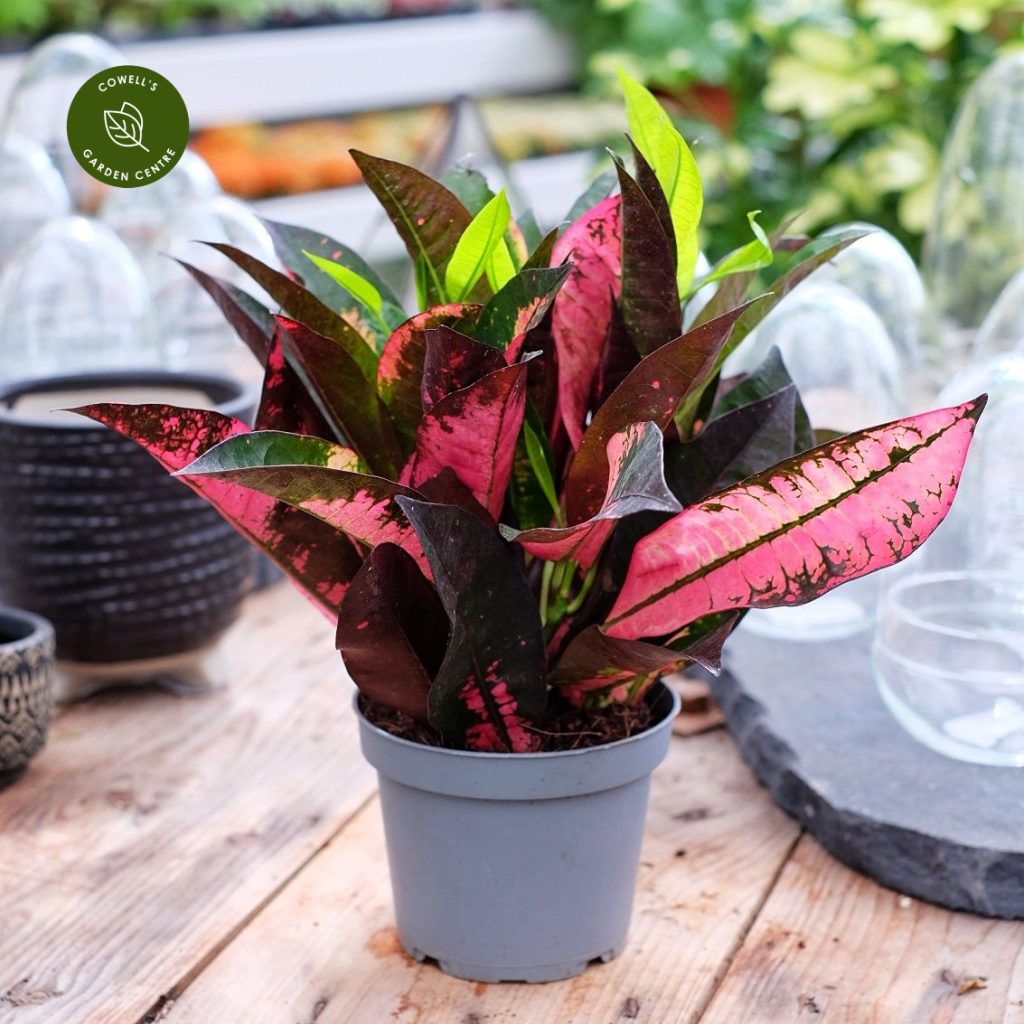
The Iceton croton plant is easily recognized for its wide and bright leaves are usually marked with large splotches of either yellow or pink. Choose a container that is wide and deep. The Iceton croton plant is prone to inadequate lighting and under-watering because its wide leaves can deprive the soil of getting an even spread of water and lighting.
Ensure the plant is placed in a location where it can receive sufficient bright indirect light.
For even spread of water, allow the soil to soak thoroughly but ensure the soil does not get waterlogged to prevent root rot that can damage the plant. The best time to fertilize the Ice ton plant is during spring and summer as that is its most active period. Reduce fertilizing during winter as it can weaken the soil.
They are easily susceptible to pests like mealybugs, spider mites, and scale insects. These pests can be easily washed off by spraying water on them or treated with pesticides.
5. Croton Magnificent
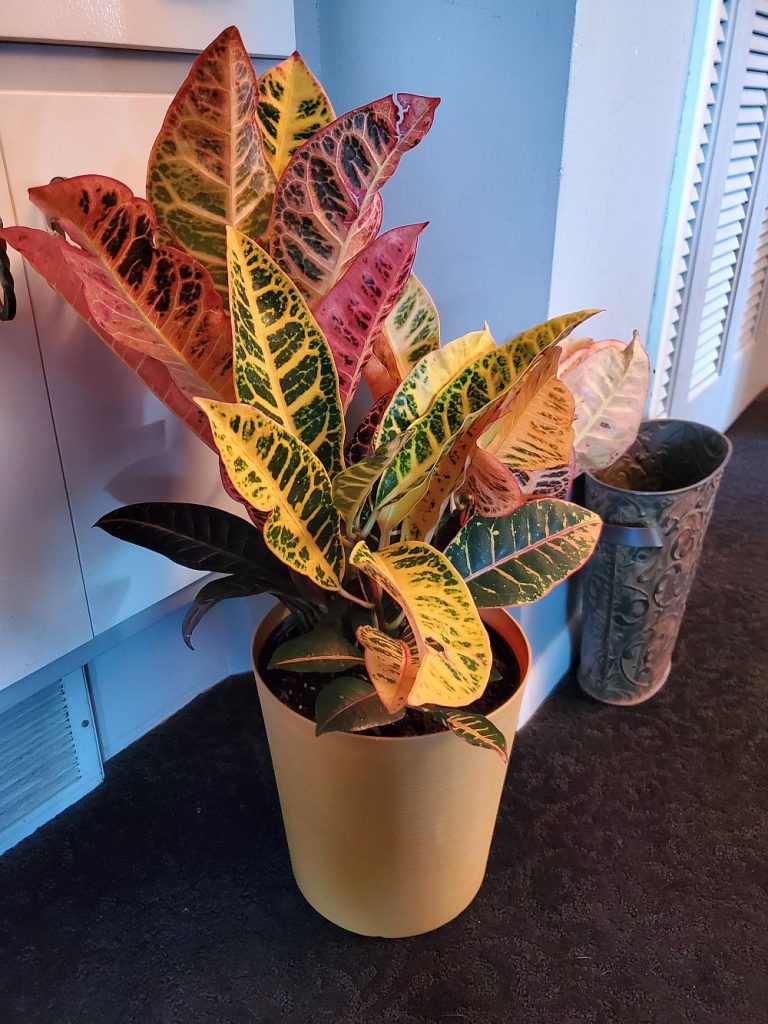
With the splashes and splotches of different colors ranging from yellow, green to pink, and yellow, the Croton magnificent earned its name.
Asides from the bright and attractive foliage color the plant exudes, it also grows out wide leaves and should never be kept in small pots or containers. It is a favorite amongst croton growers because of its multi-colored foliage design.
An interesting fact about this plant is both sides of the plant are multicolored. If you are a beginner or you have a busy schedule, the Croton magnificent is your best bet because of its ability to withstand unfavorable conditions longer than other Croton varieties.
When properly tended to, they can grow up to 6ft. Their basic requirements are adequate watering, bright indirect light, organic soil, well-drilled containers, and regular pruning to maintain shape and boost growth.
6. Gold Dust Croton Plant
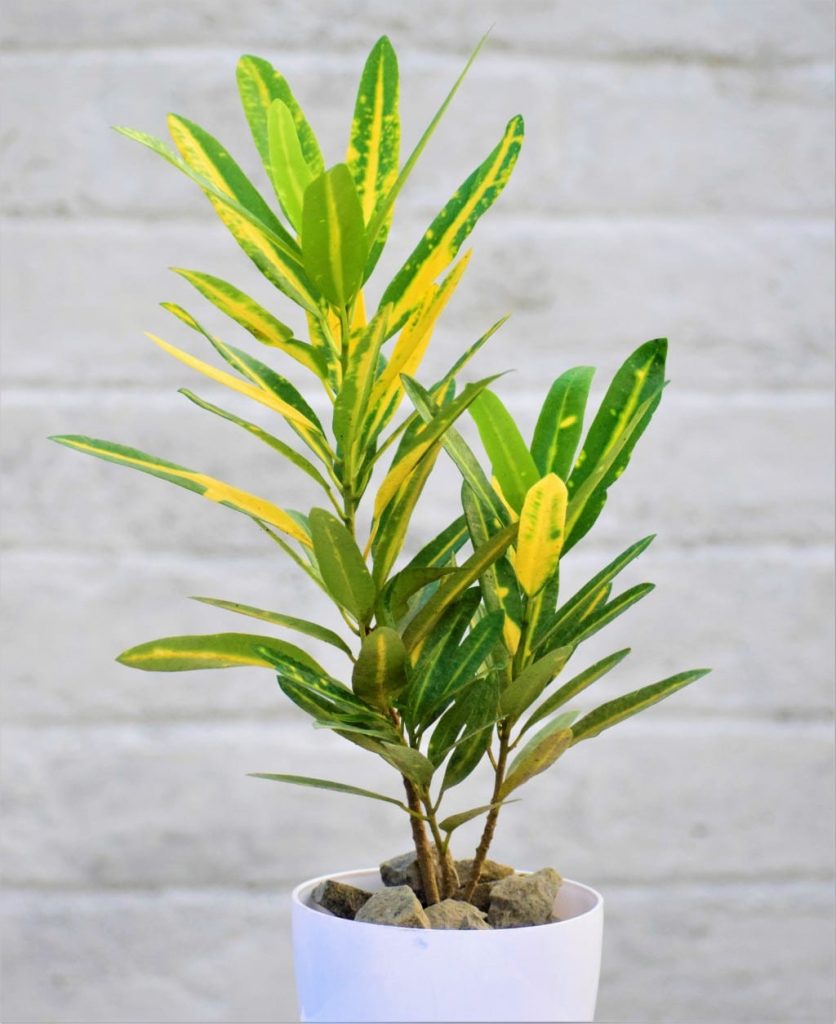
The Gold Dust Croton plant is similar to the Banana Croton Plant in foliage color; they both have dominant colors of green and yellow.
The difference between the Banana and Gold dust plants is the shape of the leaf and the Gold dust plant has more splotches than the Banana Croton plant. Under the right growing conditions, the Gold Dust Croton grows into a full mass of brightly colored wide leaves.
The Gold Dust Plant is marked with large splotches of either green or yellow color on wide leaves. They tend to grow bushy and wide, so the container used in potting them should be wide and deep, so the plant would have room to grow to its fullest capacity.
Do not grow them in Aluminum containers as chemicals from the Aluminum can seep into the soil and can damage the soil over time.
Since the Gold Dust Croton plant tends to grow into a bushy vine, ensure you water this croton variety thoroughly so all parts of the soil and root receive sufficient water. Prune regularly to allow even spread of nutrients and to nip off damaged parts of the Gold Dust Croton plant.
7. Victoria Gold Bell Plant
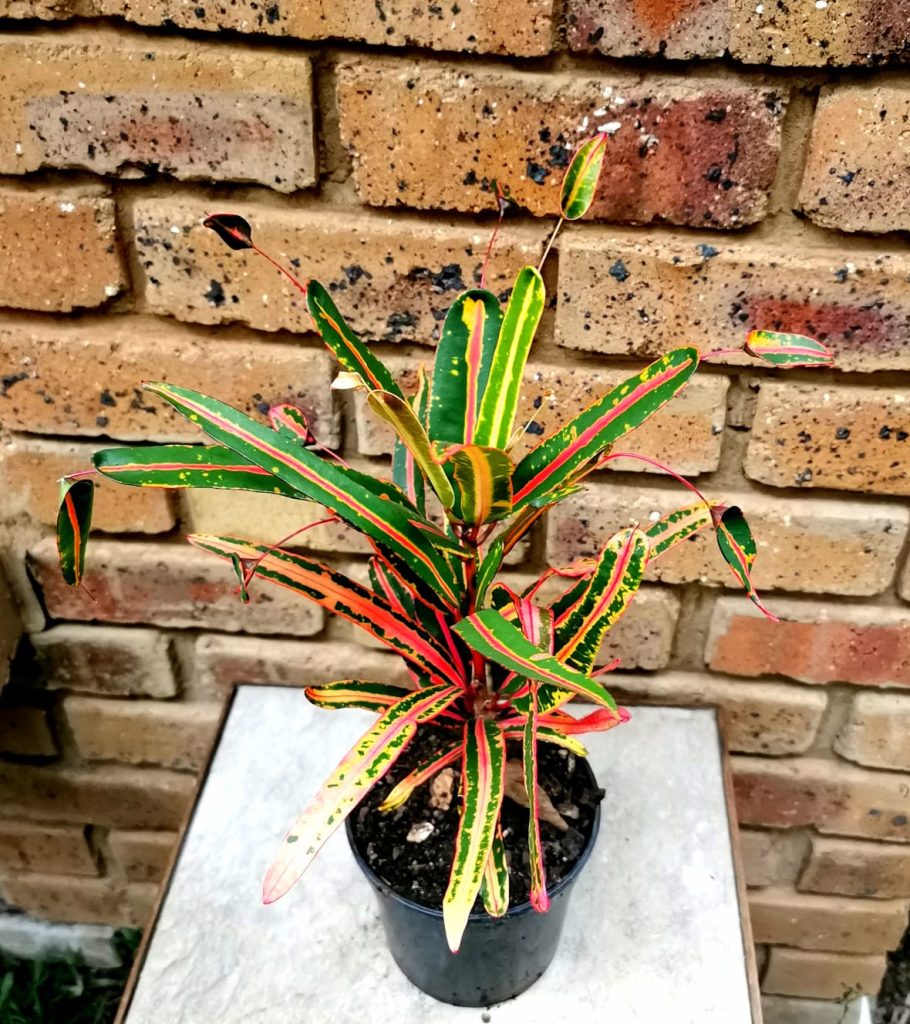
This is another distinct plant because of its long oval-shaped leaves. The leaves of the Victoria Gold Bell plant are quite longer than other Croton varieties. They are easily recognized for their unique foliage color and design.
The Victoria Bell Croton plant is marked with thick pink lines at the center of the narrow oval-shaped plant and sometimes you can find splotches of other colors like green or yellow.
Although they thrive in rich organic and moist soil, they can be affected by overwatering and their leaves would start falling; this is an indication the root has been affected. This can be easily averted by reducing watering if much damage has not been done.
The best time to plant your Victoria Gold Bell Croton is in March. The Victoria Gold Bell Croton can be grown indoors and outdoors but should be kept indoors especially if they are not mature.
8. Sunny Star Croton Plant
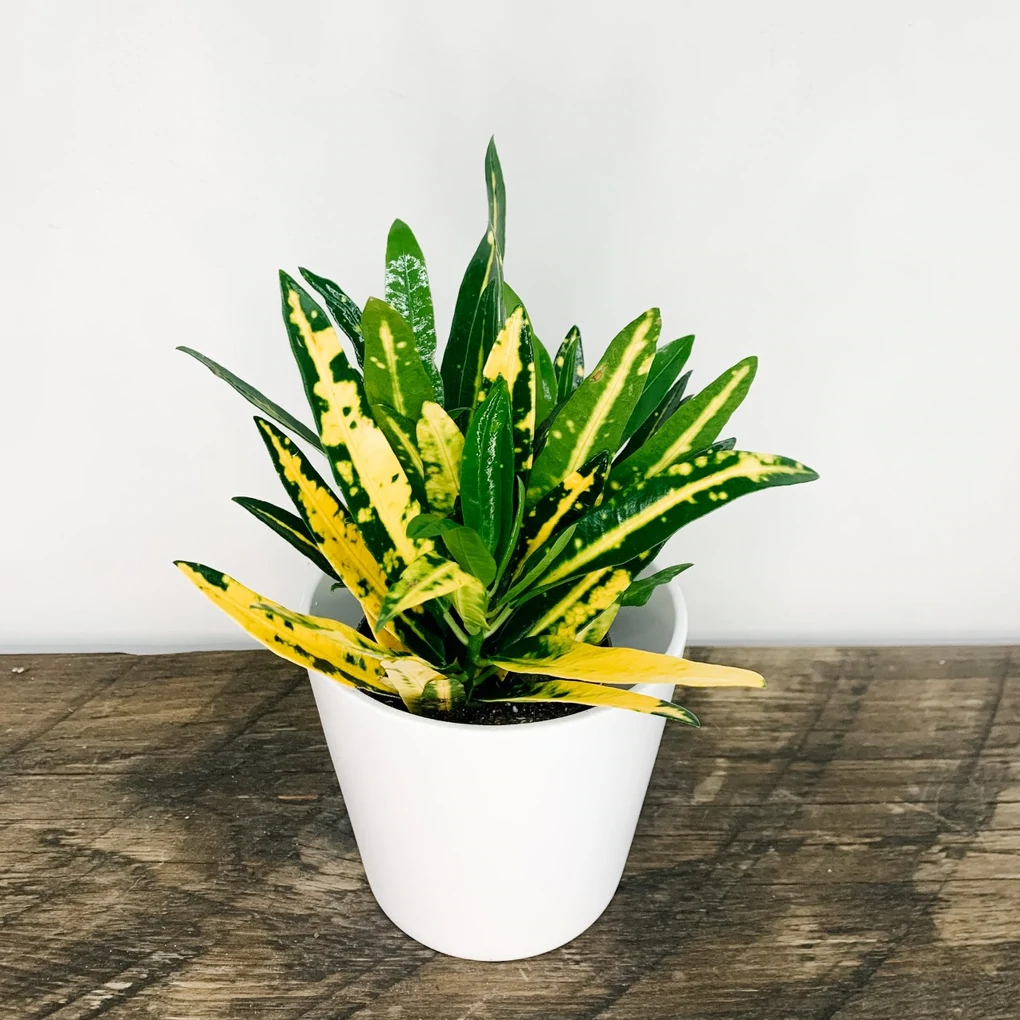
The Sunny Star plant looks almost like the Banana Croton. Their foliage appearance and color are very similar only that the Sunny Star Croton has more splotches of yellow than the banana plant and they also have longer leaves, although the width of both varieties is almost the same.
The basic requirement of the Sunny Croton is adequate watering, bright indirect light, a drilled pot that allows for good drainage of water, organic soil, and regular pruning.
Anything that affects the vigor of the sunny croton plant has affected the beauty of the plant.
If you notice the Sunny Star Croton leaves are drooping or look limp, check the soil for underwatering or overwatering, it’s either the roots have dried out or root rot has occurred. If you do not notice changes after modifying the watering schedule, consider repotting the plant to give it a fresh start.
9. Superstar Croton Plant

This easy to propagate croton plant stands out anywhere with its bright and wide yellow leaves. Some parts of the Superstar Crotons are yellow while other parts are a mixture of yellow and green, but yellow is the dominant color of the Superstar croton plant.
When placed in attractive pots and containers, they can do no small good to the interior or exterior of your home. Since the Superstar croton commands attention with its bright foliage color and position, do not place them in hidden locations but where their beauty can easily complement your home.
For the Superstar Croton plants, choose locations they can receive bright indirect light. When grown outdoors ensure they are shaded from direct sunlight as this could lead to burnt or dried leaves.
Growing them amidst other plants or trees keeps them shaded. Before watering the plant, check the soil mix to determine how much water the soil needs but never allow the soil to completely dry out before watering except if you are trying to avert overwatering.
Other basic requirements of the Superstar croton plant are balanced fertilizer, organic soil, and drilled containers.
10. Oak Leaf Croton Plant
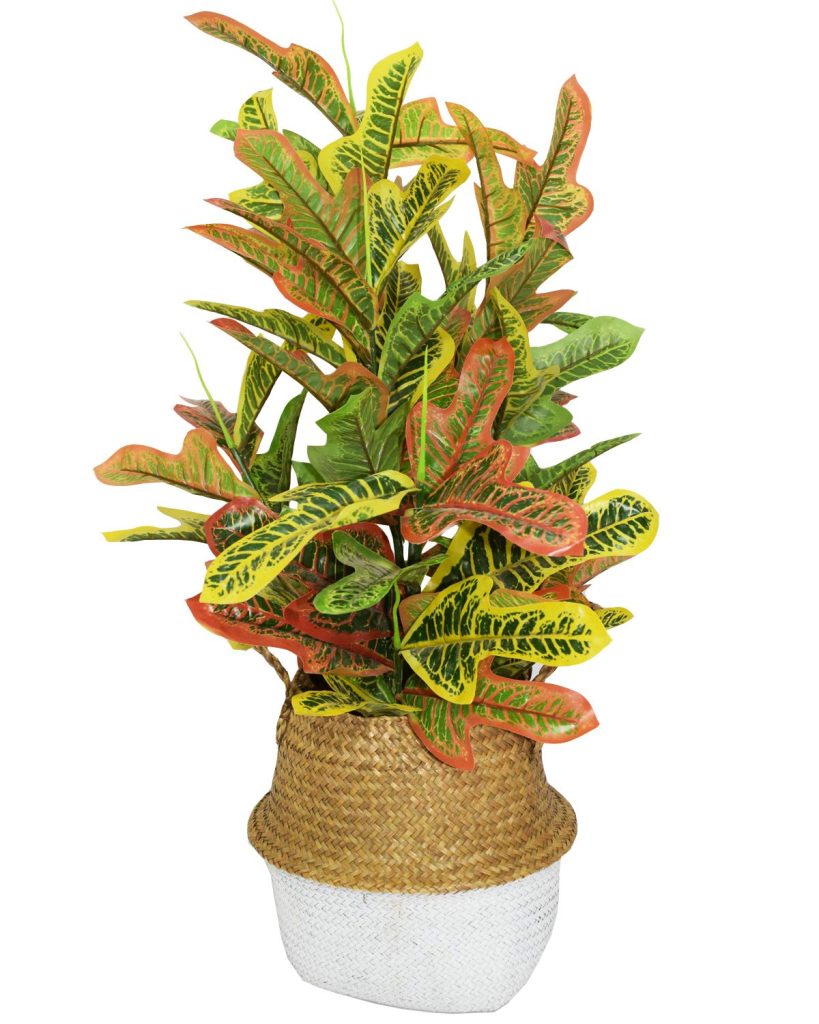
The Oakleaf croton plant has an unusual shape with yellow veined lines. The multicolored plant has colors ranging from burgundy, green and yellow.
They tend to grow long and wide leaves, so their containers should be wide enough to accommodate the growth of two or more years; this helps to lessen the number of times you change their containers since they detest frequent movement.
Move the Oakleaf croton plant as little as possible because they do not respond well to shocks and you might notice changes in the growth rate of the plant.
Most times, they respond to shock by their leaves dropping and this is not good for your plant especially when you desire a bushy croton plant. During winter, cut back on your watering and if possible move the oak leaf croton plant to an indoor location as the plant does not thrive in extreme weather conditions.
11. Andrew Croton Plant
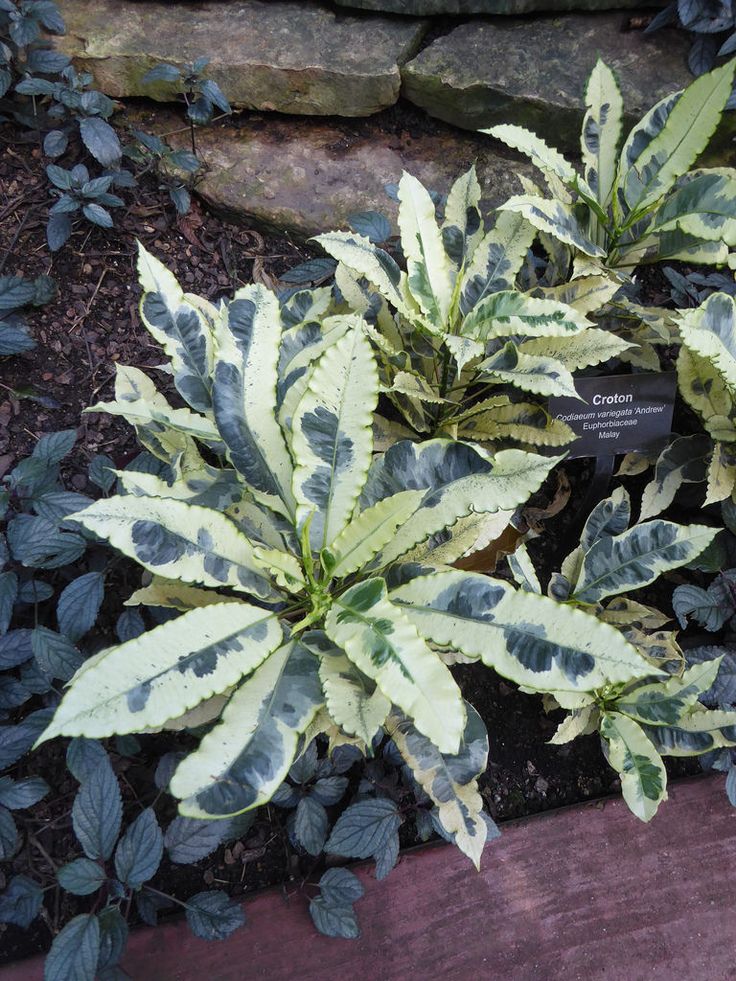
Unlike the other Croton varieties which have green, yellow, burgundy, and red colors, the dominant colors of the Andrew Croton are green and cream. The cream-colored streaks and edge of the Andrew croton plant are what makes it distinct from other croton varieties.
Although they are not as bright and attractive as the other varieties, they can still enhance the appearance of your home when placed in strategic locations with matching containers.
With proper care, the Andrew Croton plant can grow up to 5 feet. Placing them in dark locations would affect the foliage appearance as you would notice the colors of the plant and look drab. If sunlight is inadequate for the indoor plant, make use of artificial light.
If grown outdoors, look out for pest infestations to detect and combat an attack early enough before much damage is done.
12. Red Ice Ton Croton Plant
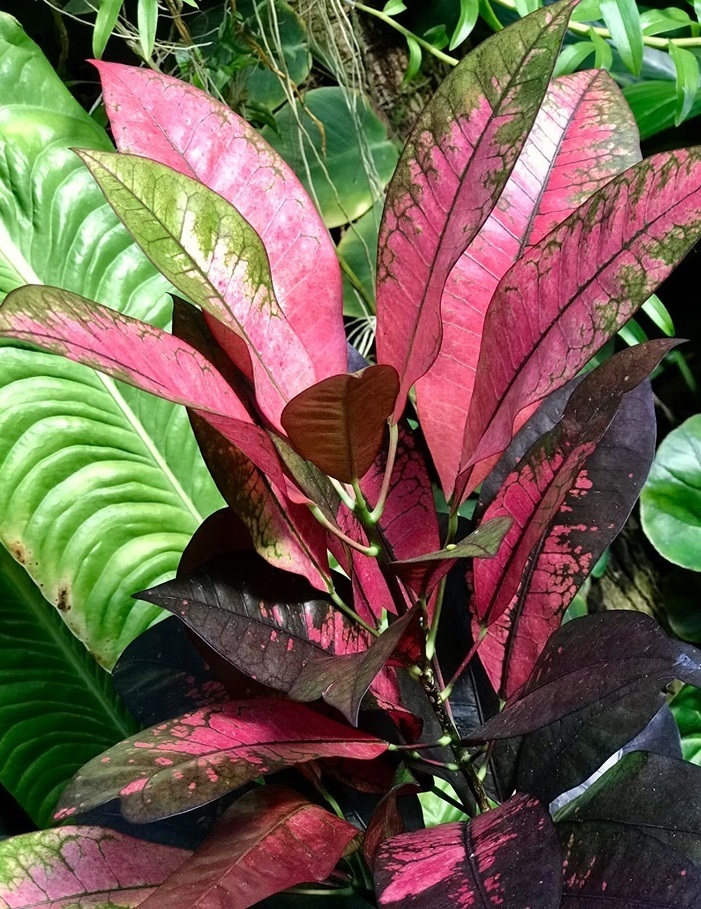
As its name suggests the dominant colors of this wide variegated plan are burgundy, pink and red.
The Red Ice ton Croton plant does not have the regular veined patterns like other varieties but has its unique pink vein patterns. Like some varieties, the Red Ice ton Croton also grows wide and long leaves and can grow into a bushy plant when properly tended to which is the desire of most croton growers.
Use wide containers for the Red Ice ton croton but ensure it is well drilled to allow easy drainage of water.
Since they are colorful plants, a change in foliage appearance would alter their beauty and this can be caused by under watering, consistent exposure to direct sunlight, overwatering, over-fertilizing, and pest infestations. All of these can be averted if preventive and corrective steps are taken early enough.
13. Bush Fire Croton Plant
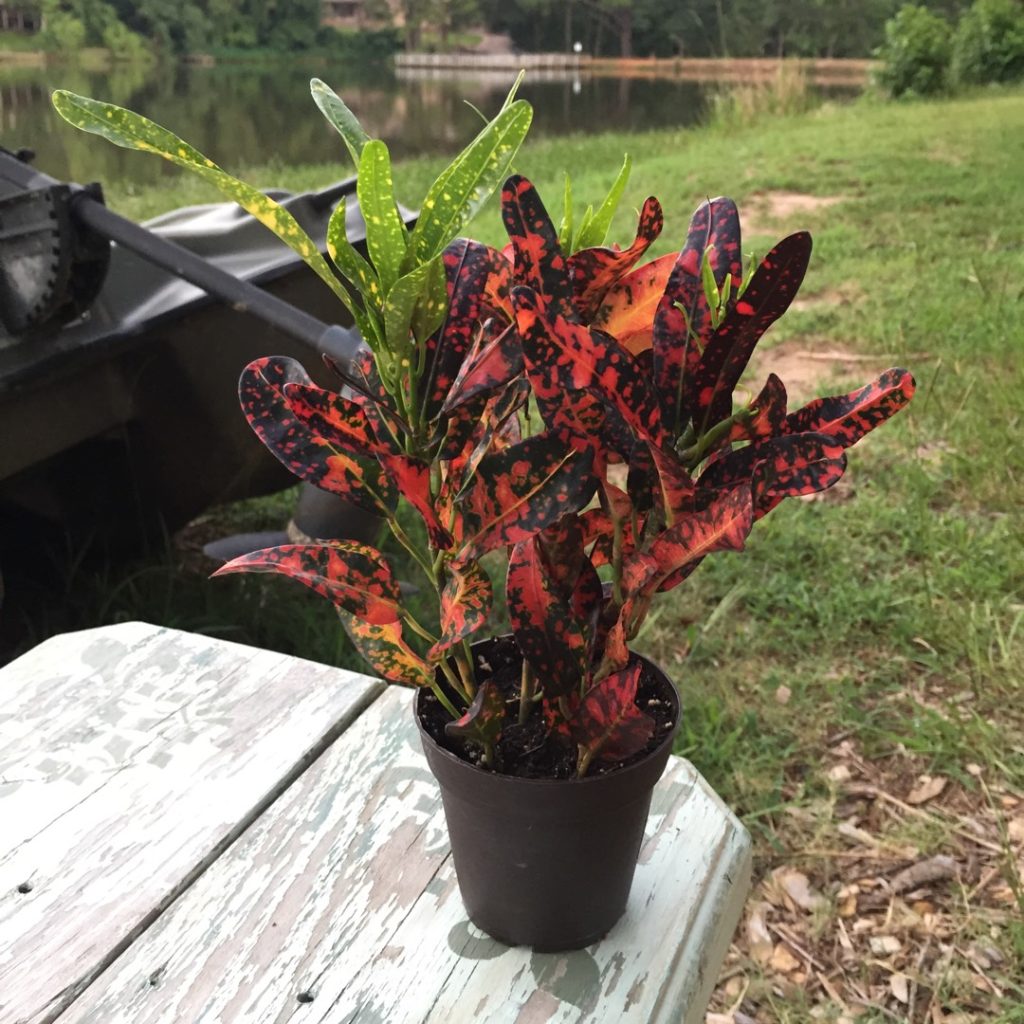
The beauty of the Bush Fire Croton plant is appreciated when it is fully grown and mature. When properly tended to, the Bush fire croton appears like a bush on fire with its long and narrow-shaped leaves. The mass of colors it exudes when nurtured makes it a perfect option if you want to ornate your home.
Just place them in plain but attractive pots and ensure they are kept in locations that can complement the theme of your home’s aesthetic design. The Bush fire requires regular misting and adequate watering. On days when your soil does not need watering, misting the leaves by spraying them with little water helps the root take in moisture.
Keep the bush fire plant away from drafts and air currents as they can weaken and damage the stem of the plant. The ideal temperature for your Bush fire croton is between 70 °F and 80 °F.
14. Lauren’s Rainbow Croton
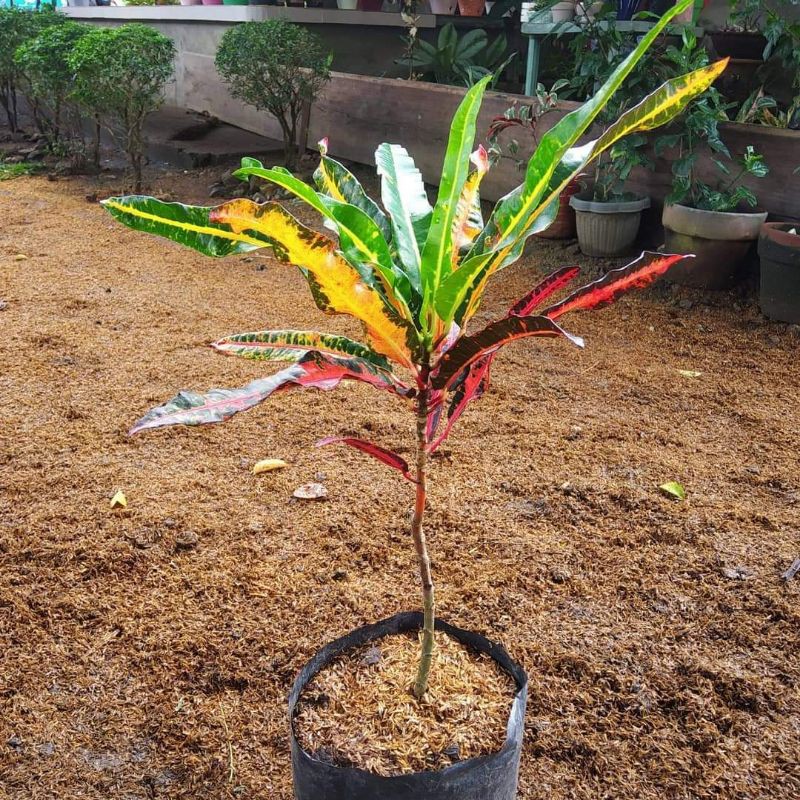
Lauren’s rainbow croton has long narrow leaves with shades of yellow, green, and deep purple. This type of croton plant likes to be planted in bright sun but not direct sunlight.
Light is needed to ensure it produces bright colorful leaves. To ensure Lauren’s rainbow croton thrives, make sure the soil stays fairly moist, not too wet, and also aim to keep its temperature between 60-85 degrees F.
This is a favorite houseplant for many plant parents. It grows up to 4 or 5 feet and its humidity and drought tolerant as well. You can grow this in a container or pot and water regularly but wait till the soil drys out before watering.
It prefers dry soil to a soggy one so don’t water too often. The average years for this croton plant are 2 to 4 years. This tends to look attractive planted in groups and it’s a stunning houseplant with proper maintenance.
15. Mammy Croton Plant
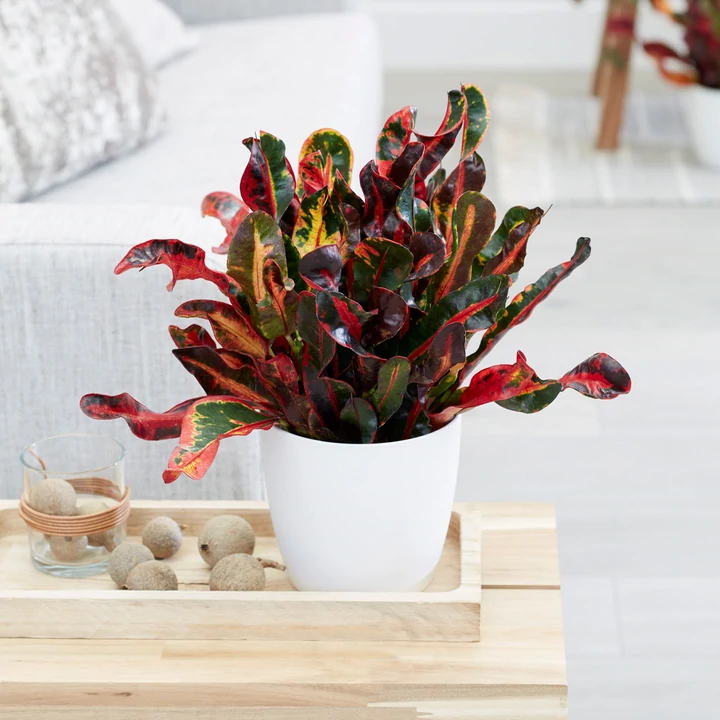
The Mammy Croton plant is similar to the bush fire croton only that the Mammy croton has curly edges and tends to grow wider and longer than the Bush fire Croton. Their foliage colors range from red, pink, green, and yellow.
Some of them have a combination of splotches and lines of these different colors. The ideal humidity level for your Florida Croton plant is between 40 and 80%.
The humidity level can be improved by misting the leaves regularly, using humidifiers, and growing in damp areas like the bathroom.
Ensure they are placed in locations where they can receive bright indirect light. Regularly prune the plant to allow for an even spread of nutrients. Combat pest infestations by spraying off with water or making use of pesticides.
Before pruning, sterilize every piece of equipment to prevent the spread of pest infestations. The Florida Croton can easily be purchased from nurseries or online stores. Their basic requirements include adequate watering, bright indirect light, well-drilled pots, organic soil, and balanced fertilizer.
Quick Guide On Caring For Croton Houseplants
Just like many other houseplants, croton needs proper care and maintenance for it to thrive. Croton is an easy houseplant to grow but it has a reputation for being fussy. However, caring for it the proper way is the best way to counter this fussy plant and make it a hard to kill houseplant instead.
There are over 100 varieties of croton worldwide and here is a quick guide on how to care for any variety you picked.
- Humidity Levels: Mist once a week if you live in a dry area, and they thrive in normal humidity of 60% all season.
- Watering: Water croton houseplant in moderation
- Sunlight: Croton thrives in full sun and will tolerate partial
- Fertilizer: Fertilize once a month to encourage growth
- Temperature: Grow croton in warm temperatures between 65 and 85 degrees.
For more detailed ways to care for croton houseplants. Check out Croton Houseplant Care Guide (2022).
Common Croton Plant Problems
Croton plants might not be as fussy as gardeners peg them to be but they are prone to certain diseases and overwatering is a common problem as well.
This stunning houseplant is easy to care for and with proper care, it can reward you with stunning flowers. You need to pay attention to the needs of your houseplant and below are common croton problems you should watch out for.
| Common Croton Plant Problems | What to Do |
|---|---|
| Pests such as mealybugs, spider mites, and caterpillars can cause damage to croton. | Get rid of these pests by washing your plant gently with soap and water and rinsing it to remove the soap. |
| Overwatering can cause the leaves to wilt. | If you notice you are watering it too often, place the plant in bright indirect sunlight. |
| Powdery dew causes a thin coat of gray or white dust to form on the top or bottom of a croton plant. | Chemical treatments like neem oil and potassium bicarbonate can b used to get rid of this. |
Vulnerable to a series of diseases and fungi. | Cutting down the affected area or transplant it into a new pot and make sure the roots are disease-free. |
Frequently asked questions on croton plants
Let us know in the comment section if you have more questions.
How do I make my croton bushy?
Croton plants do not need to be pruned to make sure they fill out. Croton plants grown in a container can be maintained as a small bush shrub and you just have to pinch it back frequently or snip off the branches or stem. Snip off the growing tips of each stem to encourage bushier plants and keep the leaves at their normal size.
What is the lifespan of a croton plant?
An indoor croton plant has a lifespan of two to four years and if you fulfill all its basic requirements it can last longer. The average lifespan of this plant sure exceeds two years but you need to keep it in an ideal condition and zone.
Are Crotons hard to keep alive?
Crotons actually hate to be moved which earns them the reputation as fussy plants. Moving croton plants can send them into a shock and cause them to drop their leaves but with proper maintenance, crotons can keep their vivid hues all year long.
Are Crotons high-maintenance?
Crotons are not exactly high maintenance but they can’t be regarded as low maintenance either. They can be quite sensitive to changes in their environments and can drop their leaves too if you move them. So, they are fussy plants but not high maintenance. You can simply prune the croton plant to keep it at a manageable size.
Do croton plants grow fast?
Croton plants are slow growers and they can grow less than 12 inches per growing season unlike other types of tropical plants. Although they are considered moderate growers due to their dense coarse leaves, it only gains less than 12 inches each growing season.
Final Note
Depending on your choice, you may decide to propagate more than one variety of the Croton plant.
Although their basic requirements are the same, some need more of the requirements such as watering and lighting. This is because some of these varieties grow very large and wide and would need more watering and light than other smaller varieties.
More houseplant guides:

